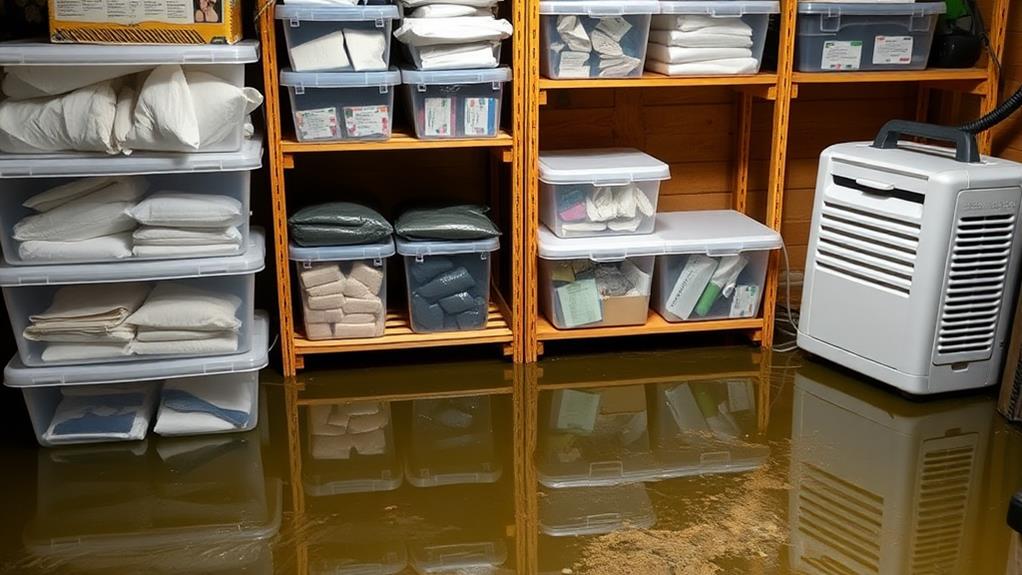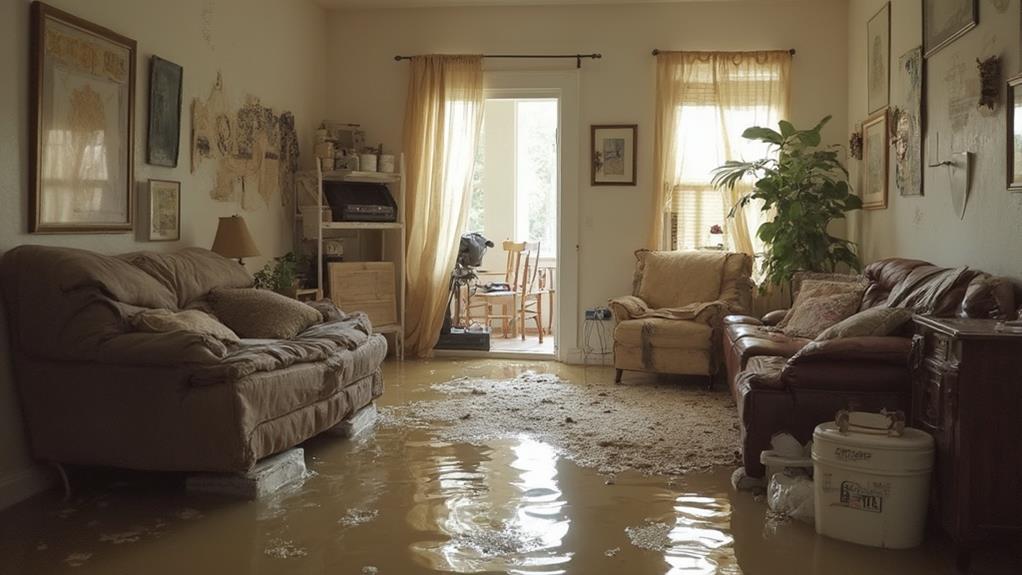To protect valuables from standing water damage, start by identifying high-risk areas in your home. Elevate important items using sturdy shelving or waterproof containers. Implement proper drainage systems, including well-maintained gutters and downspouts. Install water detection systems to provide early warnings. Use airtight plastic bins and waterproof safes for storage. Create a disaster response plan that includes documenting valuable items and establishing clear roles for family members. Consider flood insurance for additional protection. Regular maintenance and updates to these preventive measures will help safeguard your possessions. By implementing a multi-faceted approach, you can significantly reduce the risk of water damage to your valuables.
Identify High-Risk Areas

Basements, crawl spaces, and low-lying areas are prime candidates for water accumulation during heavy rains or floods. These spaces are particularly vulnerable due to their proximity to groundwater and their tendency to collect runoff. To protect your valuables, it's crucial to identify all potential high-risk areas in and around your property.
Inspect your home's foundation for cracks or gaps that could allow water infiltration. Pay close attention to areas where utility lines enter the building, as these can be weak points for water entry. Examine the grading around your home's exterior, ensuring the ground slopes away from the foundation to promote proper drainage.
Inside your home, look for signs of previous water damage, such as water stains, mold growth, or musty odors. These indicators can help pinpoint areas prone to moisture accumulation. Don't forget to assess storage areas, including closets and utility rooms, which may be overlooked but can still be susceptible to water damage.
Consider creating a risk map of your property, marking areas that require extra attention during severe weather events. This proactive approach will help you prioritize protective measures and ensure the safety of your valuable possessions.
Elevate Valuable Items
Once you've identified high-risk areas in your home, the next step is to elevate valuable items to protect them from potential standing water damage. Start by prioritizing your most important possessions, such as electronics, important documents, and sentimental items. Use sturdy shelving units, raised platforms, or waterproof storage containers to lift these items off the floor.
For larger furniture pieces, consider using furniture risers or cinder blocks to elevate them several inches above ground level. This can provide crucial protection in the event of minor flooding. In basements or areas prone to moisture, install wall-mounted shelves to keep books, photos, and other vulnerable items safe from water damage.
When storing valuable items in closets or storage areas, use plastic bins with tight-fitting lids instead of cardboard boxes, which can quickly deteriorate when exposed to moisture. For important documents and irreplaceable items, consider using waterproof safes or safety deposit boxes at your local bank. Remember to regularly reassess your elevated storage solutions and adjust as needed, especially if you acquire new valuable items or if your home's layout changes.
Use Waterproof Storage Solutions

In addition to elevating items, implementing waterproof storage solutions is crucial for protecting valuables from standing water damage. Waterproof containers, such as airtight plastic bins, provide an effective barrier against moisture intrusion. These containers come in various sizes and can accommodate a wide range of items, from important documents to electronics and sentimental objects.
For larger valuables, consider investing in waterproof safes or cabinets. These specialized storage units are designed to withstand partial submersion and offer an added layer of security against theft. When selecting waterproof storage options, look for products with high IP (Ingress Protection) ratings, which indicate their level of water resistance.
Vacuum-sealed bags are another excellent option for protecting clothing, linens, and other fabric items from water damage. These bags not only create a waterproof seal but also compress the contents, saving space and making them easier to transport in case of evacuation.
For irreplaceable documents or photos, consider using waterproof document pouches or laminating services. Digital backups stored in cloud-based systems or on waterproof external hard drives provide additional protection against water damage and ensure that important information remains accessible even if physical copies are compromised.
Install Water Detection Systems
A crucial step in safeguarding your valuables against standing water damage is the installation of water detection systems. These systems provide early warning of water intrusion, allowing for swift action to prevent extensive damage. Modern water detection systems utilize advanced sensors placed strategically throughout vulnerable areas of your home or storage space.
When selecting a water detection system, consider options with wireless connectivity and smartphone integration. These features enable real-time alerts, even when you're away from the premises. Look for systems that offer multiple sensor types, including those designed for detecting surface water and others for monitoring humidity levels.
Install sensors near potential water sources such as water heaters, washing machines, and air conditioning units. Place additional sensors in basements, crawl spaces, and areas prone to flooding. For comprehensive protection, consider systems that integrate with automatic shut-off valves, which can halt water flow upon detecting a leak.
Regularly test and maintain your water detection system to ensure its effectiveness. Replace batteries in wireless sensors as needed and update software for smart systems. By implementing a reliable water detection system, you significantly reduce the risk of standing water damage to your valuable possessions.
Create a Disaster Response Plan

While water detection systems offer early warnings, preparing for potential disasters requires a comprehensive approach. Creating a disaster response plan is crucial for minimizing damage to your valuables from standing water.
Begin by identifying the most vulnerable areas in your home and prioritizing which items to protect or evacuate first. Document the location of important documents, irreplaceable heirlooms, and valuable electronics.
Establish clear roles and responsibilities for family members during an emergency. Designate meeting points and evacuation routes, ensuring everyone knows how to safely exit the property. Create a contact list of emergency services, insurance providers, and restoration professionals. Store this information both digitally and in a waterproof container.
Regularly review and update your plan, conducting practice drills to familiarize household members with the procedures. Consider investing in waterproof storage containers or elevated shelving units for storing valuables. Keep a supply of sandbags, plastic sheeting, and water pumps readily available. By developing a well-thought-out disaster response plan, you can significantly reduce the impact of standing water on your precious belongings and ensure a more efficient recovery process.
Maintain Proper Home Drainage
Proper home drainage plays a crucial role in safeguarding your valuables from standing water damage. A well-designed drainage system directs water away from your home's foundation, preventing water accumulation and potential infiltration. Regularly inspect and clean gutters and downspouts to ensure they function effectively during heavy rainfall. Extend downspouts at least five feet away from your home's foundation to prevent water from pooling near the structure.
Maintain proper grading around your home, ensuring the soil slopes away from the foundation at a rate of six inches over a distance of ten feet. This grade allows water to flow naturally away from your property. Install French drains or underground piping systems in areas prone to water accumulation. These systems collect excess water and redirect it to a safe discharge point away from your home.
Consider installing a sump pump in your basement or crawl space to remove any water that may seep through the foundation. Regularly test and maintain the pump to ensure its reliability during emergencies. Additionally, seal any cracks or gaps in your foundation walls to prevent water intrusion. By implementing these drainage measures, you significantly reduce the risk of standing water damage to your valuables.
Consider Flood Insurance Options

Despite implementing effective drainage systems, homeowners should recognize that unforeseen events can still lead to water damage. Flood insurance provides an additional layer of protection for valuable possessions and property. Standard homeowners insurance policies typically do not cover flood-related damages, making separate flood insurance crucial for comprehensive coverage.
The National Flood Insurance Program (NFIP) offers policies through approved insurance providers. These policies cover both building property and personal contents, with varying coverage limits. Private insurers also offer flood insurance options, often with higher coverage limits and additional benefits.
When considering flood insurance, assess your property's flood risk by consulting FEMA flood maps. Understand the policy's coverage limits, deductibles, and exclusions. Some policies may have waiting periods before coverage takes effect, so plan accordingly.
For high-value items such as antiques, artwork, or jewelry, consider additional riders or separate policies to ensure adequate coverage. Document your possessions with photographs and detailed inventories to facilitate claims processes.
Regularly review and update your flood insurance policy to reflect changes in property value, renovations, or newly acquired valuable items. By carefully evaluating flood insurance options, homeowners can better protect their assets from standing water damage.
Frequently Asked Questions
How Long Can Items Survive Underwater Before Sustaining Permanent Damage?
The duration items can survive underwater varies widely depending on their composition and the type of water. Generally, electronics may fail within minutes, while metals can corrode in hours or days. Organic materials like wood can warp rapidly.
Can Valuables Be Restored After Water Damage, and at What Cost?
Like a phoenix rising from the ashes, many valuables can be restored after water damage. Professional restoration services can salvage items, but costs vary widely—from $100 to $10,000+—depending on the item's value, damage extent, and restoration complexity.
Are There Specific Cleaning Methods for Water-Damaged Items?
Water-damaged items require specific cleaning methods depending on the material and extent of damage. Techniques may include air drying, dehumidification, freeze-drying, and specialized treatments for electronics, documents, and textiles. Professional restoration services often employ advanced cleaning technologies for optimal results.
What Documentation Is Needed for Insurance Claims on Water-Damaged Valuables?
Great Caesar's ghost! For insurance claims on water-damaged valuables, document the following: detailed inventory, photographs of damage, original receipts or appraisals, repair estimates, and a comprehensive incident report. Maintain all communication records with your insurance provider throughout the process.
How Can Sentimental Items Be Preserved if They Can't Be Moved?
To preserve sentimental items that can't be moved, consider using waterproof containers, elevating them above potential flood levels, employing dehumidifiers, and applying protective sealants. Professional conservation services may also offer specialized treatments for delicate or irreplaceable objects.
Conclusion
In conclusion, protecting valuables from standing water damage requires a multifaceted approach. By identifying vulnerable areas, elevating items, utilizing waterproof storage, installing detection systems, and developing emergency plans, homeowners can significantly reduce risks. Proper drainage maintenance and flood insurance further bolster defenses. While these strategies may seem like a drop in the bucket individually, collectively they form a robust shield against water damage. Implementing these measures ensures peace of mind and safeguards precious possessions from potential devastation.

